Deborah J. Ross's Blog, page 40
March 31, 2021
Today's Jane Austen Quote
March 29, 2021
Beware Fake Science News!
 Barbara McClintock, geneticistScience news articles abound, everything from the results of carefully designed peer-reviewed research studies to fear-based rumors and anti-science biased conspiracy theories. How are we to discern which are reliable, which are hype based on misinterpretation, flawed studies, and the like, and which are clickbait nonsense?
Barbara McClintock, geneticistScience news articles abound, everything from the results of carefully designed peer-reviewed research studies to fear-based rumors and anti-science biased conspiracy theories. How are we to discern which are reliable, which are hype based on misinterpretation, flawed studies, and the like, and which are clickbait nonsense?The first thing I do is look at the source. Mediabiasfactcheck and other sites provide information as to the right-left biases and factual accuracy of a given source, although not of a particular story. Science Based Medicine is also helpful. I've been known to search under "Is Dr. So-and-So a quack?" and get useful answers.
I also check my own reactions: Is this too good to be true? Is it at odds with what I understand about science (my academic background is biology and health sciences)? Have I seen an article in a trusted source (such as the newsletter from Center for Science in the Public Interest) debunking this or similar claims? I've been also known to check with friends with special expertise in the field.
The Conversation offers some guidelines on assessing the quackery scale of science new stories. Their suggestions:
1. Has the story undergone peer review?
Scientists rely on journal papers to share their scientific results. They let the world see what research has been done, and how.
Once researchers are confident of their results, they write up a manuscript and send it to a journal. Editors forward the submitted manuscripts to at least two external referees who have expertise in the topic. These reviewers can suggest the manuscript be rejected, published as is, or sent back to the scientists for more experiments. That process is called “peer review.”
Research published in peer-reviewed journals has undergone rigorous quality control by experts. Each year, about 2,800 peer-reviewed journals publish roughly 1.8 million scientific papers. The body of scientific knowledge is constantly evolving and updating, but you can trust that the science these journals describe is sound. Retraction policies help correct the record if mistakes are discovered post-publication.
Peer review takes months. To get the word out faster, scientists sometimes post research papers on what’s called a preprint server. These often have “RXiv” – pronounced “archive” – in their name: MedRXiv, BioRXiv and so on. These articles have not been peer-reviewed and so are not validated by other scientists. Preprints provide an opportunity for other scientists to evaluate and use the research as building blocks in their own work sooner.How long has this work been on the preprint server? If it’s been months and it hasn’t yet been published in the peer-reviewed literature, be very skeptical. Are the scientists who submitted the preprint from a reputable institution? During the COVID-19 crisis, with researchers scrambling to understand a dangerous new virus and rushing to develop lifesaving treatments, preprint servers have been littered with immature and unproven science. Fastidious research standards have been sacrificed for speed.
A last warning: Be on the alert for research published in what are called predatory journals. They don’t peer-review manuscripts, and they charge authors a fee to publish. Papers from any of the thousands of known predatory journals should be treated with strong skepticism.
2. Be aware of your own biases.
Beware of biases in your own thinking that might predispose you to fall for a particular piece of fake science news.
People give their own memories and experiences more credence than they deserve, making it hard to accept new ideas and theories. Psychologists call this quirk the availability bias. It’s a useful built-in shortcut when you need to make quick decisions and don’t have time to critically analyze lots of data, but it messes with your fact-checking skills.
A confirmation bias can be at work as well. People tend to give credence to news that fits their existing beliefs. This tendency helps climate change denialists and anti-vaccine advocates believe in their causes in spite of the scientific consensus against them.
3. Correlation is not causation!
Just because you can see a relationship between two things doesn’t necessarily mean that one causes the other.
Even if surveys find that people who live longer drink more red wine, it doesn’t mean a daily glug will extend your life span. It could just be that red-wine drinkers are wealthier and have better health care, for instance. Look out for this error in nutrition news.
4. How were the experiments designed?
The gold standard is a double blind (neither the researchers nor the subjects knew which group got the active ingredient), placebo-controlled (half of the subjects didn't), with a large enough test population. And was it tested on rats or mice -- or humans?
5. Do the "experts" have an ax to grind?
Beware of medical products and procedures that sound too good to be true. Be skeptical of testimonials. Think about the key players’ motivations and who stands to make a buck.

March 26, 2021
Short Book Reviews: Juliette Marillier at Her Most Addictive
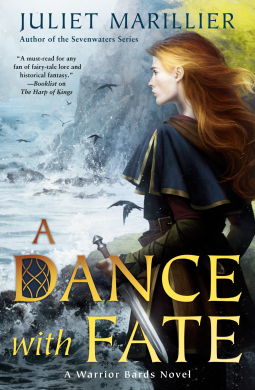
A Dance with Fate, by Juliet Marillier (Ace)
In The Harp of Kings, only the most promising students qualify for the elite Swan Island school for assassins, warriors, and spies. Two such were Liobhan, a gifted singer and even more gifted fighter, and self-exiled prince, Dau. Sent together on a spy mission along with Liobhan’s bard brother, Brocc, it was hate at first sight and an ongoing challenge to work together for the success of the mission. Now Brocc has followed his fae heritage into the Otherworld, leaving Liobhan and Dau to continue honing their skills and an increasingly friendly rivalry. A freak training accident leaves Dau blind. Liobhan blames herself, since the two were sparring at the time, but so does Dau’s vicious, abusive older brother. Rather than expose the secrets of Swan Island, the elders strike a bargain with Dau’s family: he is to return home, where he will be cared for, and Liobhan will serve as an indentured bondswoman for a year. Dau’s brother has agreed not to harm her physically, but there is nothing to stop his cruelty.
The situation is a recipe for disaster. Dau is right to be fearful of being at the mercy of his older brother and heir to the estate, doubly so because of the extreme vulnerability due to his blindness. Old traumas haunt him, threatening to drag him into suicidal despair. It will take all Liobhan’s healing skills, empathy, and bloody-minded authority to keep him alive. Meanwhile, the violently aggressive Crow People launch ever-increasing attacks on both fae and human communities.
Engaging, dramatic, romantic, and thoughtful, A Dance with Fate is Marillier at her most addictive. Highly recommended.

March 24, 2021
Today's Jane Austen Quote
March 22, 2021
Auntie Deborah Answers Your Writing Questions
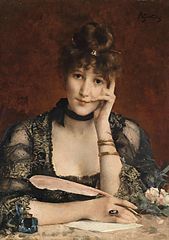
Dear Auntie Deborah, How do I stick with my story idea and finish writing it?
Deborah: You may be confusing a story idea with a story structure. The idea is just the starting point, without character development, rising tension and resolution, turning points, or plot. If this is true, you’re diving into writing before you have a story — a story meaning an emotionally satisfying journey you take the reader on.
Some writers can take an idea and launch it into a story while writing, but most of us can’t — or else end up revising many times to whip that shapeless manuscript into something that resembles a true story. Your description of losing motivation suggests that you, like me, need to have more structure in place before beginning.
What do I mean by structure? I need to have a hook or inciting incident — the action, situation, crisis, or decision that fuels the first part of the story. Then something goes wrong (or right, or unexpected) and spins the story in a new direction — that’s the first plot point. I need to know what it’s all building toward, and also the feeling or flavor I want to leave the reader with (sadness, triumph, satisfaction, chocolates on the pillow?). I need at least 2 or 3 characters I’m in love with, although I don’t necessarily need to know what happens to them. I write all this down, do flow charts and maybe a map or two. If I’m submitting on proposal, I’ll need to flesh it out into a proper synopsis plus the first 3 chapters, but for writing for myself on spec, that’s enough to get me going.
If these concepts are unfamiliar with you, I encourage you to learn more about storycraft and the journey from idea to plot/character/dramatic arc. Ideas aren’t a bad place to start, they’re just not enough.
Dear Auntie Deborah: My critique group keeps giving me contradictory advice. I'm at a loss as to which direction to take. Help!
Deborah: It is as important to know which advice to ignore as which to pay attention to! Without knowing the sources of your opinions, I can’t evaluate their validity, but — BUT — I am always leery of anyone who tells me how to fix problems in my own work. This was true when I began writing on a professional level 35 years ago, and it certainly is true now. What helps me are comments like, “I’m confused about x,” or “This didn’t work for me,” or “I don’t care what happens to this character.” In other words, careful readers marking where they had problems. Then it’s up to me, the author, to discern where I went wrong and how I want to remedy it. (This is how my publishing editor and I work together, by the way.)
My second point is that learning to write and working on a specific project are two different things. A project problem may highlight a skill you need to strengthen, but someone telling you how to improve it makes it their story, not yours, and isn’t likely to help you improve as a writer.
I wonder if you might fare better by not showing your work to anyone until it is completed to the best of your ability. Otherwise you run the risk of distorting your artistic vision to please others so much that you lose your authentic creative voice. When you are ready for feedback, seek out trusted readers (who need not be writers themselves but who have keen sensitivity to their own reactions) or writers a little ahead of you in their careers. Make it clear what kind of feedback you want: What worked for you? What didn’t? Where did you lose interest? Was the result satisfying? And leave the nuts and bolts of prose craft for a separate discussion.
Dear Auntie Deborah: I think my novel has way too much speech in it. What should I do?
Deborah: By speech, I am assuming you mean dialog. Dialog is a wonderful storytelling tool, but like any other tool, there are some things it’s great for and some things it’s not. If you find yourself with page after page of “talking heads” — nothing but dialog — you might be trying to use it for purposes it isn’t suited for.
So what might dialog be used for, and what other storytelling tools might you substitute? Does it advance the plot? (Alternative: narrative description of action.) Does it reveal character? (You bet, but so do interior monologs/thoughts and description of action/reaction.) Does it heighten tension? (It can, especially between characters, but so can description and pacing. Think of what happens if a character pauses before replying, or looks away, or shifts posture or vocal tone — all these things require narrative, not dialog).
One way to think of this difference is to imagine your pages of dialog as a movie script. That’s all it is, just what each character says. But a movie is much more; it’s acting, scenery, music, and so forth. That’s where your narrative and description come in. If the movie were just talking, we’d all go to sleep. So imagine what you see and hear (not words, but other sounds) that isn’t dialog, and weave that in between the speech.
In other words, if you can accomplish the same storytelling goal without using dialog, don’t use it. Try that as an exercise, and see if it highlights those areas where dialog shines.
Dear Auntie Deborah: What happens when one’s writing turns clunky and trying to express anything becomes a lesson in futility?
Deborah: This happens to us all. I’ve been writing professionally for over 35 years and it still happens to me! The most important thing to remember is that it will pass. The second most important thing is that if you can manage to be curious and nonjudgmental, and to observe your thoughts, you can learn interesting things about how your mind works.
In order to get my internal critic out of the way, I change media. So instead of composing at the computer keyboard, I switch to longhand, or dictating/voice-recognition software, or an old-fashioned typewriter. I act out scenes aloud. I switch creative fields altogether. I dance or play a musical instrument or sing or go bird-watching or knit or paint…all of these are ways of expressing yourself, just using different parts of your mind and body. Then I can return to the story at hand feeling more confident and refreshed.
I repeat, be gentle with yourself. Think of this as a common bond with every successful writer. If the words aren’t flowing, sidestep them. They’ll be there when you’re ready to return.

March 19, 2021
Book Reviews: The Lady Astronaut Series
Mary Robinette’s Lady Astronaut Series: Three Novels and A Novella
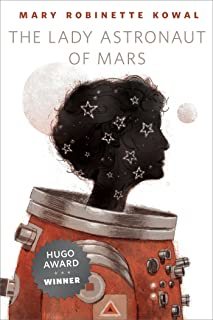 The Lady Astronaut(novella)
The Lady Astronaut(novella)This was the tale that began it all. The Lady Astronaut has the shape and emotional clarity of short fiction while evoking a larger story both in time and space. Thirty years ago, in the early 1950s, a meteorite strike on the Eastern United States ignited a space race. The central character, Elma York, was once a pioneering astronaut, world-famous as The Lady Astronaut of Mars. Now in her 60s, she still yearns to return to space, but the upcoming mission is a one-way trip and her beloved husband has only a short time left to live. Elma’s dilemma is the centerpiece of a beautifully crafted, perfectly balanced story.
The Calculating Stars
A concept like The Lady Astronaut cries out for development, and here we journey backward
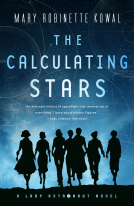
in time to the origin story. In 1952, history took a different turn when a meteorite obliterated most of the East Coast of the United States. Elma and Nathanael York were among the survivors, eventually making their way to the new capitol and the newly formed International Aerospace Coalition. Here he becomes the lead engineer and she, a computer. They understand all too well the danger that the dust and water vapor thrown into the atmosphere will lead first to a prolonged drop in Earth’s temperatures, and then a runaway greenhouse effect. It’s entirely likely that the world will become uninhabitable. If humanity is to survive, it must be on another planet. They have time, but only if they devote all their resources to it. Thus, the Space Race of the 1960s begins a decade earlier, and with a very different mission.
Elma’s experience as a wartime pilot, along with her genius for mathematical computations, makes her a prime candidate for astronaut training. But this is the 1950s, when sexism as well as racism run rampant and the head of the program is determined to find any excuse to exclude women. A few white women might stand a chance but minorities are out of the running, which is a terrible loss because many of the superb women pilots trained in World War II are Black or Asian.
At this point, the story shifts focus from an alternate history disaster thriller to an examination of how an earlier space race would have run up against the social institutions and prejudices of the day. Racism, attitudes towards women, and antisemitism, are pervasive. Characters range from those, like Elma, who forge alliances and friendships, to rabidly pro-apartheid South African astronaut trainees. Elma’s personal experiences as a Jew and a woman in a male-dominated field make her not only sympathetic in herself but believable in her advocacy of equality. Elma witnesses the struggles of her Black colleagues and friends from the outside, never truly able to understand but willing to acknowledge her limitations. She is all too aware of when she blunders into thinking she understands the lives of her Black friends, even as she is willing to use her white privilege to open doors for them.
As a note: The alliance between Blacks and Jews dates back at least to the 1950s, when both were targets of white supremacist groups like the KKK. In 1958, the Hebrew Benevolent Congregation Temple in Atlanta, Georgia, was bombed by a group calling itself the Confederate Underground. The bombing was in retaliation for the outspoken activism of the senior rabbi, who criticized segregation and advocated for racial equality.
Elma is anything but a cardboard soapbox character. She suffers from a crippling anxiety disorder. I love flawed characters and I cheer them on as they struggle to overcome their challenges. Elma’s social anxiety is severe enough that the physical symptoms threaten to overwhelm her, yet she never gives up. She uses mathematics as a mantra to calm herself. Despite her attempts to avoid being in the spotlight, she’s catapulted into fame with an appearance on “Ask Mr. Wizard” and subsequently became the public face of the space program as “The Lady Astronaut.” When the stresses of public appearances become too much, she seeks medical help and receives a prescription for Miltown (meprobamate), an early anxiolytic drug. The medication is of tremendous help, even though Elma feels obliged to keep it a secret or risk losing her chance at actually going into space.
Elma isn’t perfect, but she doesn’t need to be in order to be extraordinarily competent and inspiring. People with mental illness can and do achieve amazing things, and there is help. Even without the gripping plot, this message in itself lifts The Calculating Stars above the typical disaster science fiction tale.
I should also mention that although I could not follow the math, physics, and engineering details, I loved them. They offered a peek into the scientific literacy and skills of the generation that in our time send humans into orbit around the Earth and to the Moon.
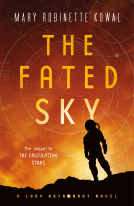 The Fated Sky
The Fated Sky While the mission to colonize other planets proceeds apace, conditions on Earth are deteriorating. Many believe that resources ought to be better spent in helping those who have been displaced by the meteorite strike and the subsequent social upheavals. The political climate is swinging against the exploration of space, with groups like “Earth First” gaining members. Their actions grow increasingly violent, from taking Elma and other astronauts hostage when their shuttle crashes to sabotaging facilities on the Moon. If The Calculating Stars was “how it all started,” The Fated Sky follows close on its heels in fine style with “how many things can go wrong.”
The Relentless Moon
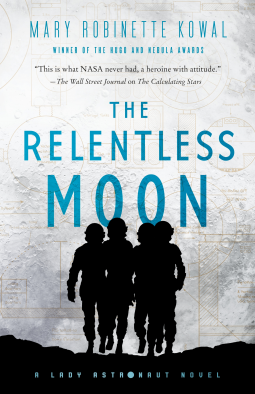
Elma York is now on her way to Mars, but the drama closer to home is anything but over. Fellow astronaut Nicole Wargin tries to balance her dreams of joining the colony on the Moon with her duties as the wife of Kansas governor, a likely candidate for president. Like Elma, Nicole wrestles with mental illness, in her case anorexia. She’s had it a long time and has solid coping strategies. But when sabotage cuts the Moon off from Earth and a polio epidemic rages through the colony, and she is one of the few members capable of discovering the saboteurs and stopping them, not to mention keeping everyone alive, she finds herself at risk of a serious relapse.
Like its predecessors, The Calculating Starsand The Fated Sky, The Relentless Moon pairs hard-science thriller excitement with sensitive characters and a sweet, enduring love story.
That's it...so far. I certainly hope there will be more "Lady Astronaut" stories!

March 17, 2021
Today's Jane Austen Quote
March 15, 2021
[personal rant] Another Rant About Vaccination

Back in April, 2019, I posted a personal rant, Why I Am Adamant About Vaccination. This was way before Covid-19 and the more than half million American deaths. The issue was childhood vaccination against measles, mumps, rubella, and the like. I shared a deeply personal story:
During my first pregnancy, an antibody titer that revealed I’d had rubella as a child. A series of conversations with my mother and sister put together the pieces of my own family tragedy due to contagious disease. In most cases, rubella is a mild infection, except when a woman is pregnant. Contracted in the first 12 weeks of pregnancy, babies have an 85% chance of Congenital Rubella Syndrome, including deafness, cataracts, heart defects, neurological issues, and other significant problems. The risk goes down as pregnancy progresses.
This is what happened to my baby sister.
My mother had been mildly ill, and I had been, as well. My sister Madeleine was born blind and with heart defects. She lived only 6 months.
At the time (1950) there was no vaccine, but there is now. Today this loss would have been completely preventable by vaccination, not just for the mother but for all the people around her. This is a public health issue that involves us all.
So when I hear the anti-scientific justifications for refusing to vaccinate children, I think of the baby that could have lived and the grief that haunted my mother the rest of her life. I don’t care about personal choice or fears of governmental conspiracies. None of them count in my mind against the lives of my baby sister, and everyone’s sisters and brothers.
I honestly do not care what their reasons are. This is not a “tomaytoe, tomahtoe” discussion where understanding through respectful dialog is the goal. This is about whether we as human beings are capable of acting for our common good (which in this case includes protecting our most vulnerable from preventable severe disability and death itself), at the cost of a much smaller risk and a little inconvenience. Do not ever try to convince me that this area of public health is an infringement on civil liberties, or is a plot on the part of Big Pharma. My sister’s life was more precious than your conspiracy theories.
Fast forward to 2020. People are dying or suffering chronic, debilitating effects from Covid-19.
Not a handful here and there but by the tens and hundreds of thousands. As much as 80% of all Covid-19 patients experience some degree of long-term symptoms. All we had to stem this dreadful pandemic were tried-and-true public health measures: wearing masks, social distancing, isolating the sick, hand-washing and disinfection. And the same anti-science nonsense is going on. People are refusing to wear masks. They’re gathering indoors, although every public health agency and responsible news outlet is telling them this is the way the virus spreads. Even as cases and deaths surge and surge again, they reject both logic and science.It’s 2021 now and we have several effective vaccines. None of them is perfect in terms of absolute prevention of Covid-19, but all of them have proven remarkable in 100% protection against severe disease, hospitalization, and death. Even so, lies abound. Vaccine refusal, especially when coupled with rejection of public hygiene measures, threatens us all.
Add to the mix: the new variants. These are mutations of the original Covid-19 strain that are either more contagious, more likely to cause severe disease, or possibly resistant to the existing vaccines. And what’s the best way to stop them?
Rob Stein at NPR writes:
The vaccines are rolling out, and so far it looks like they work against the variants to protect people from getting very sick or dying. If enough people in the U.S. can get vaccinated fast enough while also keeping up safe behaviors, this could prevent another major surge of cases and deaths. It could also help prevent new, dangerous variants from evolving because the more the virus spreads, the greater chance it has to mutate.
In summary, I had long since run out of patience with people who put the lives of the
community, including our most vulnerable, above their own convenience and anti-science
bias. I have none whatsoever for those who refuse Covid-19 vaccination, discourage others from getting it, refuse to wear masks, yell in the faces of those who are trying to protect themselves, and so forth. As far as I’m concerned, they’re destined for Dante’s Eighth Circle of Hell, realm of corrupt politicians, hypocrites, and sowers of discord. Or possibly the Ninth, wherein lie those who betray their communities, kindred, and guests.

March 12, 2021
Short Book Reviews: Fear and Longing in 19th Century Spiritualism
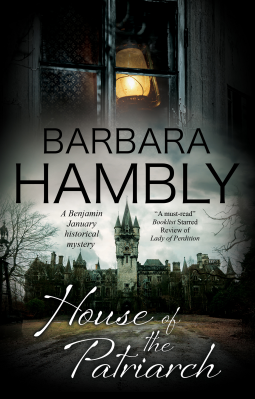
House of the Patriarch, by Barbara Hambly (Severn House)
This latest “Benjamin January” mystery begins with yet another commission to find a missing daughter. In this case, the lost girl is a young lady from a modestly well-to-do white family, recently introduced into society but given to fanciful questions. The last thing Ben wants is to leave his family and put himself at risk of being nabbed by slave-catchers, or worse. But the fee will mean his family’s security during a long lean season.
That said, House of the Patriarch stands apart in its depiction of the social experiments that flourished at the time. Spiritualism (séances, communicating with the dead), communal living, charismatic leaders, all abounded. The Mormon church and others trace their beginnings to this time. The “House” to which Ben ventures is the resident of one such leader. Since the leader has also a reputation for helping escaped slaves on their route to Canada, Ben disguises himself as such and quickly infiltrates the hidden areas of the house. Needless to say, plot twists and dark secrets abound.
Hambly marries her knowledge of history and social customs to a pitch-perfect story of human fears and longing.

March 10, 2021
Today's Jane Austen Quote
 Jane Austen by her sister, Cassandra
Jane Austen by her sister, Cassandra “I do not want people to be very agreeable, as it saves me the trouble of liking them a great deal.”
– Jane Austen, Letter to her sister







